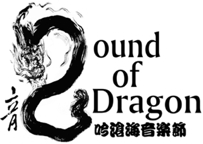Wind Instruments 吹管樂器 :
Chinese transverse flutes are called Dizi (笛子). They are made of different types of bamboo tubes and available in various sizes and keys. “The tube is closed at the blowing end with a cork, open at the bottom. Distributed along the upper surface are a blow-hole, membrane hole and six finger-holes, with two end-holes on the underside which define the length of the vibrating air column and may be used to attach a string or decorative tassel” (Yueqi, Thrasher & Wong 2011). Traditionally, a dizi is made of one piece of bamboo tube. Today, many dizi are made of two pieces of bamboo tubes. Adjusting the tightness of how the two pieces connect together allows the player to fine tune the instrument. The membrane hole is covered by a fine piece of bamboo skin from the inner surface of the tube, which produces the unique buzzing tone.
Xiao 簫 read more
Chinese vertical flutes are called xiao.
Sheng 笙
Suona 嗩吶
Bowed String Instrument 拉弦樂器 :
The root of Chinese bowed string instruments goes back over one thousand years ago in Central Asia, where the first Chinese spike fiddle came from. Today there are many bowed string instruments in China, made with different materials and into different sizes. They are folk or opera instruments popular in different regions. The erhu, originally popular in the south, became standardized as a classical instrument in the 20th century. At the same time, the modern Chinese orchestra has been formed, modelling the western orchestra. Together the erhu, gaohu, and zhonghu make up the string section in the orchestra. They are the classical instruments studied in conservatories and used in solo, chamber, and orchestral music.
Erhu 二胡 erhu history compose for the erhu
The erhu is played while held on the lap. Its two strings are tuned to a fifth (D4 & A4), with the bow placed between them. The erhu has no fingerboard. The player places the fingers on the strings without pressing them against the wood beck, giving the flexibility to apply different degrees of pressure on the strings to alter the tone. The erhu is usually made of ebony, sandalwood or rosewood, with a snakeskin resonator. In recent years, artificial erhu skin has been developed, and erhu makers are working on improving its sound quality to resemble better the snake skin. A popular instrument in solo and ensemble music, erhu’s expressive sound resembles the human voice and is deeply rooted in the vocal traditions.
Gaohu 高胡 Tuned to G4 & D6, a 5th higher than the erhu, the gaohu is popular in Canton province as a lead instrument in chamber ensemble and Cantonese opera orchestra. It is also used in modern Chinese orchestras.
Zhonghu 中胡 Tuned to G3 & D4, a 5th lower than the erhu, there is a small solo repertoire for the zhonghu. It is also used in modern Chinese orchestras. However, cello and double bass provide the real low end of the string section in Chinese orchestras.
Lower Tone Erhu 低音二胡 Tuned to G3 & D4 or A3 & E4, its sound box is slightly bigger than the regular erhu and smaller than the zhonghu. The lower tone erhu is designed to perform the famous erhu solo piece “Moon Reflection on Er-Quan”, and therefore sometimes called “Erquan Erhu”. When this piece was first recorded in 1950, performed by the composer and street musician A-Bing, the construction and tuning of the erhu had not been standardized. A-Bing used thicker strings and tuned his instrument lower than today’s erhu. The piece does not sound as good on the standard erhu tuned to D4 & A4. This piece uses a lot of the higher register, which usually does not sound good on the zhonghu neither. Therefore, erhu makers designed the lower tone erhu.
Plucked String Instruments 彈撥樂器 :
Zheng (Guzheng) 箏(古箏)
The zheng is a plucked half-tube wood zither with movable bridges, over which a number of strings are stretched. The parent instrument of the Asian long zither family, the history of the zheng can be traced back to more than 2500 years ago. While the ancient zheng had 12 or 13 silk strings, modern instruments usually have 16, 21 or 25 strings, constructed of metal, or steel wound with nylon. It is traditionally tuned to an anhemitonic pentatonic scale, but many modern scales range from combinations of different pentatonic scales, to diatonic and semi-chromatic scales
Qin (Guqin) 古琴
Pipa 琵琶
Liuqin 柳琴
Ruan 阮 read more
Sanxian 三弦
Yangqin 揚琴
Percussion Instruments 打擊樂器:
Paigu (Chinese tuned tom tom) 排鼓
Dagu (Chinese bass drum) 大鼓
Chinese Opera Gongs 大鑼、中鑼、小鑼
Chinese Cymbals 大鈸、小鈸
Temple Blocks (Muyu) 木魚
